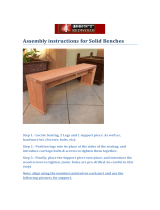
27
Threaded joints
Always tighten all screws and nuts rmly after each adjustment. Screws
may come slightly loose with time, especially when the wheelchair is
in constant use; we therefore advise you (or your Küschall/Invacare
dealer) to control the tightness of the screws monthly.
Life expectancy
When the wheelchair is used on a daily basis, it is under constant
pressure and is subject to natural wear. Under such conditions, and
assuming the wheelchair is regularly serviced, the estimated life expec-
tancy is 5 to 8 years for all Küschall wheelchairs. The more scarcely the
wheelchair is used, the longer this expectancy will be.
Using the wheelchair
In order to prevent any accident, please follow these instructions carefully:
Driving the wheelchair
- Avoid driving on steep surfaces and give special care in presence of
gravel or when the surface is either wet or uneven.
- Drive at night only under secure light conditions (see and be seen)
- Drive carefully over side obstacles, steps or door frames.
- Give special care when driving up-hill (best is to have a companion
standing at the back of the wheelchair).
- Always adjust your speed to the situation and the environment.
Transfers and loading of the wheelchair
Make sure you have been trained by professional staff before undertaking
such actions. If your legs cannot support your weight, a side transfer is
the solution: move the wheelchair alongside the object in question and
position it at a slight angle, so that the rear wheel and the footplate on the
transfer side touch it. Apply both wheel locks. Remove the armrest on the
transfer side. Move forward so that you sit on the front edge of the seat.
Place one hand on the surface you are transfering to and the other on the
frame or seat of the wheelchair. Then shift your centre of gravity towards
the object of transfer and pull yourself over.
Brakes
The supplied brakes are foreseen as immobilisation brakes. Using them
while in movement is not recommended. Should the brakes still be
misused, küschall design and Invacare cannot be held responsible.
General safety precautions and useful tips
- When entering or leaving your wheelchair do not stand on the footplates.
- Maintain proper balance at all times.
- Do not attempt to pick up objects by reaching between your knees.
- Do not attempt to reach objetcs by moving forward on the wheelchair.
- Do not lean over the top of the backrest
- Do not hang heavy loads or objects on the backrest.
GB





















